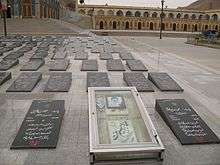Mohammad Ebrahim Hemmat
| Mohammad Ebrahim Hemmat محمد ابراهیم همت | |
|---|---|
| Nickname(s) |
Haj Hemmat (حاج همت) General of Kheibar (سردار خیبر) |
| Born |
2 April 1955 Shahreza, Iran |
| Died |
14 March 1984 (aged 28) Majnoon Island, Iraq |
| Allegiance |
|
| Years of service | 1979–1984 |
| Commands held |
27th Mohammad Rasulullah Brigade 27th Mohammad Rasulullah Division Zafar Command 11th Qadr Corps |
| Battles/wars | |
| Awards |
|
Mohammad Ebrahim Hemmat (Persian: محمد ابراهیم همت b. on April 2, 1955, Shahreza, Isfahan) is an Iranian military leader.
After the Islamic Revolution, he joined the Islamic Revolutionary Guard Corps and, in the early 1980s, was a military leader in the Iran-Iraq War. He was killed during Khaybar, at age 28.
Early life
After graduating from high school, he entered Isfahan Daneshsara of Teacher Training. He was admitted in Tarbiat Moallem University of Isfahan to earn his Associate degree. He undertook military service in Artillery Division of Isfahan and was put in charge of kitchen duties. During this period, Hemmat became familiar with revolutionary elements and intellectuals, studied Islamic and banned books and started activities against the Shah's regime.
In 1977, Hemmat started teaching in a Middle school in Shahreza.[2] There, he associated with revolutionary Clergymen and Qom Seminary and became more familiar with the personality and thoughts of Imam Khomeini. Hemmat tried hard to introduce Islamic and revolutionary ideas to his students. These activities led him to be noticed by SAVAK and warned not to continue.
Gradually, Hemmat became the head of anti-regime and revolutionary youth in Shahreza. Because of his anti-regime speeches, he was prosecuted by SAVAK and had to escape. To avoid capture, he left for Firouzabad but SAVAK still chased him. He lived in Yasuj, then Gachsaran, Dogonbadan, and finally Ahvaz where he lived for several months before returning to Shahreza. He actively led protests there.
He was sentenced to death due to his anti-regime activities and had to disguise his appearance and struggle in secret until the Islamic revolution.[3][4]
After Islamic Revolution
Following the Revolution, Hemmat and his companions worked to establish order in the city. They formed a Committee of the Islamic Revolution and the IRGC of Shahreza. Hemmat was appointed director of IRGC's Public Relations in Shahreza.
In 1980, he was dispatched to Paveh, Kurdistan, to calm unrest. Hemmat spent nearly two years in Kurdistan province; he had a significant effort to deal with the Kurds' poverty. Hemmat served two years as the commander of IRGC in Paveh. The locals became upset when he wanted to leave the region.[3]
Iran–Iraq war
When Iraq invaded Iran, Hemmat joined the military and departed for the southern front. Ahmad Motevaselian and Hemmat were commissioned by the commander-in-chief of the IRGC to form the Muhammad Rasool-Allah Brigade.
He was director of a significant part of Operation Fath ol-Mobin. Hemmat played an important role in Operation Beit ol-Moqaddas as the deputy commander of the Muhammad Rasool-Allah Brigade. He participated in Operation Beit ol-Moqaddas and the liberation of Khorramshar, as well as commanding Operation Ramadan and Muslim Ibn Aqil occurred at the same time. He was eventually killed during Operation Kheibar, at just 28 years old. After a grand funeral procession, his body was buried in Martyrs Cemetery of Shahreza.[3]
Operations
Personal life

Hemmat was married to Jila Badihian with whom he had two sons.[3]
Legacy
Hemmat Expressway, Shahid Hemmat Metro Station and Hemmat Underpass in Tehran is named after him.
References
- ↑ Poursafa, Mahdi (January 20, 2014). گزارش فارس از تاریخچه نشانهای نظامی ایران، از «اقدس» تا «فتح»؛ مدالهایی که بر سینه سرداران ایرانی نشسته است [From "Aghdas" to "Fath": Medals resting on the chest of Iranian Serdars]. Fars News (in Persian). Retrieved October 21, 2014.
- ↑ "The martyrdom of Haj Mohammad EbrahimHemmat". www.irdc.ir. Retrieved 19 November 2014.
- 1 2 3 4 "Shahid Ebrahim Henmat".
- ↑ "The Biografy of martyr Muhammad Ibrahim Hemmat". www.tebyan.net. TEBYAN CULTURAL AND INFORMATION CENTER. (in Persian)